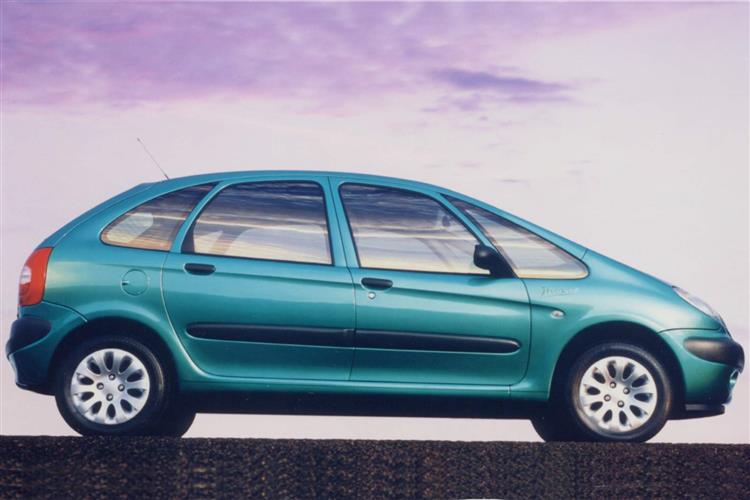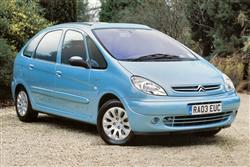I AM THE EGG MAN (some text hidden) --NONE--
BY ANDY ENRIGHT
Introductionword count: 94
What was the best selling mini MPV in the UK in 2001? Get the dunce's hat on if you plumped for the Fiat Multipla or the Nissan Almera Tino. If you opted for the Vauxhall Zafira or the Renault Scenic you were close, but no cigar. The car that topped the chart was the Citroen Xsara Picasso. Why? A combination of keen pricing and an attractive all-round blend of qualities proved irresistible to UK buyers. This equals plenty of choice for the used buyer although genuine bargains may be somewhat thin on the ground.
Modelsword count: 20
Models Covered: June 2000- to date: 5 door Mini-MPV 1.6, 1.8, 2.0 petrol, 1.6HDI, 2.0HDI diesel [LX, SX, Desire, Exclusive]
Historyword count: 173
Just when Citroen looked like slipping into mainstream respectability the company unveiled the Xsara Picasso. The ovoid 'push-me-pull-you' styling was something of a surprise as was the avant-garde interior and clever seating system, Citroen draped this package over tried and tested mechanicals from the mainstream Xsara range, thus cutting overheads. The range has remained largely unchanged since the launch in June 2000, with a 95bhp 1.6, a 117bhp 1.8-litre engine and a 90bhp HDi diesel to choose from in either LX or upscale SX guise, although the 1.8 was only ever offered in SX trim. At the start of 2002, the Exclusive trim level started arriving in dealers with body-coloured mouldings, Estoril alloy wheels and digital air conditioning among a host of other extras. The 1.6-litre HDI engine came along in early 2004 with more power and better economy than the 2.0-litre HDI diesel alternative. The C4 Picasso was launched at the start of 2007 but the Xsara version continued to be available, serving as a budget alternative to its more advanced sibling.
What You Getword count: 563
Citroen weren't diverted by gimmicky seating plans or niche markets that never really existed. Instead they aimed the Xsara Picasso at the heartland of mini-MPV buyers and scored a bullseye. The result - in interior terms at least - is arguably the most original car of its kind yet produced. You realise this as soon as you sit behind the wheel and look - into nothing. There are no dials - just a digital display to your left in the centre of the dashboard, part of which can be turned off to avoid distraction at night. You realise it on discovering that the gear lever sprouts from the dashboard, leaving the floor clear for you to walk through to the back seats. You realise it when you open the boot to find a fold-out trolley that avoids the need to decant the weekly shop in the supermarket car park. Somebody at Citroen has thought long and hard about what families really want. Research suggests that hardly any buyers in this sector have more than three children - so five seats were deemed perfectly adequate. Roadburning performance was found to be equally unnecessary, so the three mainstream Xsara hatchback engines were deemed to be quite sufficient. At first acquaintance, that centre digital display seems a little strange, but you get used to it. Incorporated in it is a standard trip computer as well as a stereo display and the graphics for the optional satellite navigation system. It's not the best example of its type, being quite a long way distant with some very small markings. It isn't even angled towards the driver very effectively, but the information relayed is very comprehensive. Outside, the Picasso manages to look futuristic and inoffensive at the same time - doubtless the effect the designers were seeking. It's 225mm higher than the Xsara hatchback on which it is based (which makes it seem much bigger) but just 60mm longer ('shrinking' the car when it comes to tight parking spaces). Probably the biggest difference over the conventional Xsara is the wheelbase, 220mm longer to enable the inclusion of five full-sized seats. That makes all the difference when it comes to sitting in the rear: the Scenic, in contrast, condemns the middle passenger to a seat narrower than the outer two. As you'd expect, the rear seats fold, collapse forward or can be removed completely (as long as you can find somewhere to leave them). Collapse the centre seat and you create a multi-function work or play area that includes a clipboard-style paper holder. There are rear picnic tables, under-floor storage compartments, a drawer under the front passenger seat, a huge glovebox and clever door pockets moulded to take cans, cups or even huge 1.5-litre bottles. What you'll really remember from your first showroom visit however is that 'modubox' trolley which normally sits flat-packed, attached to the boot wall. When required, you simply unclip it, extract the telescopic handle and wheels and wheel it off with as much as 18kg inside. The whole thing feels a little flimsy but that aside, you have to hand it to the design team for lateral thought. All five variants have dual front and side airbags, anti-lock brakes, remote control central locking, immobiliser and power front mirrors and windows while the SX versions also come with air conditioning, front fog lamps and a CD player.
To see the full road test text contact us on 0330 0020 227
Pictures (high res disabled)


|
Scoring (subset of scores)
Category: MPV People Carriers
| Performance | |
| Handling | |
| Comfort | |
| Space | |
| Styling, Build, Value, Equipment, Depreciation, Handling, Insurance and Total scores are available with our full data feed. | |



